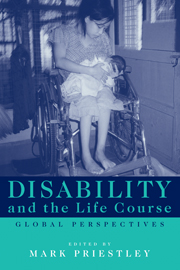Book contents
- Frontmatter
- Contents
- List of figures
- List of tables
- Notes on contributors
- Preface
- Acknowledgements
- A brief note on terminology
- I Concepts
- II Methods and stories
- 6 Life event histories and the US independent living movement
- 7 A journey of discovery
- 8 Using life story narratives to understand disability and identity in South Africa
- 9 Social change and self-empowerment: stories of disabled people in Russia
- 10 Lifting the Iron Curtain
- 11 Revisiting deaf transitions
- 12 The hidden injuries of ‘a slight limp’
- III The politics of transition
- Index
12 - The hidden injuries of ‘a slight limp’
Published online by Cambridge University Press: 30 September 2009
- Frontmatter
- Contents
- List of figures
- List of tables
- Notes on contributors
- Preface
- Acknowledgements
- A brief note on terminology
- I Concepts
- II Methods and stories
- 6 Life event histories and the US independent living movement
- 7 A journey of discovery
- 8 Using life story narratives to understand disability and identity in South Africa
- 9 Social change and self-empowerment: stories of disabled people in Russia
- 10 Lifting the Iron Curtain
- 11 Revisiting deaf transitions
- 12 The hidden injuries of ‘a slight limp’
- III The politics of transition
- Index
Summary
With the title, I am fashioning a paradox. From the classic insight of Sennett and Cobb (1972) I take the ‘hidden injuries’ that imply suppression and gross injustice. The term ‘slight limp’, on the other hand, is to remind the reader and myself that although I am not ‘normal’, I am not ‘really’ disabled. In the long view, the fact that I am capable of writing this out means no less than that I am proclaiming emancipation, and furthermore, that at long last I am willing to cope with the issue of how normality is processed and structured on a personal level.
I will try to make my point of view clear by talking about how and where, in the course of my life, I have experienced normality, absorbed setbacks, and occasionally reversed them. My thesis is that normality and abnormality are experienced in on-going processes of situated sociality, mediated by macro-structured perceptions, awarenesses and discourse, and are irrationally embodied. The micro-processes and the macro-structures are interwoven according to differently proportioned models in different stages of the life span.
Agency and the self
If agency is the ability to make decisions on action, I am an agent. I am constantly making decisions about what I can and what I cannot do. I use the computer, I read books, I cook and bake, I play the piano, I lecture, I vote and eat, I shop and go ‘out’.
- Type
- Chapter
- Information
- Disability and the Life CourseGlobal Perspectives, pp. 136 - 148Publisher: Cambridge University PressPrint publication year: 2001
- 1
- Cited by

